ST elevation myocardial infarction EKG examples: Difference between revisions
No edit summary |
No edit summary |
||
| Line 4: | Line 4: | ||
'''For the main page on ST elevation MI, click [[ST elevation myocardial infarction|here]]'''. | '''For the main page on ST elevation MI, click [[ST elevation myocardial infarction|here]]'''. | ||
==ST Elevation Myocardial Infarction EKG Examples== | ==ST Elevation Myocardial Infarction EKG Examples== | ||
Shown below is an example of an | Shown below is an example of an EKG of STEMI demonstrating the evolution of an infarct on the EKG. ST elevation, Q wave formation, T wave inversion, normalization with a persistent Q wave. | ||
[[Image:STEMI evolution.png|center|800px]] | [[Image:STEMI evolution.png|center|800px]] | ||
---- | ---- | ||
Shown below is an example of | Shown below is an example of EKG illustrating pathologic ST elevation. | ||
[[Image:Pathologic_ST_elevation.png|center|800px]] | [[Image:Pathologic_ST_elevation.png|center|800px]] | ||
---- | ---- | ||
Shown below is an example of | Shown below is an example of EKG demonstrating ST elevation in lead V1 and aVr; reversal of V6. | ||
[[Image:ST elevation in V1 and aVr.jpg|center|500px]] | [[Image:ST elevation in V1 and aVr.jpg|center|500px]] | ||
---- | ---- | ||
Shown below is an example of | Shown below is an example of EKG demonstrating acute inferior ST segment elevation MI (STEMI). Note the ST segment elevation in leads II, III, and aVF along with reciprocal ST segment depression in leads I and aVL. | ||
[[Image: | [[Image:EKG 001.jpg|center|800px]] | ||
---- | ---- | ||
Shown below is an example of | Shown below is an example of EKG illustrating Acute inferior myocardial infarction with RV involvement. | ||
[[Image:STEMI 1.jpg|center|800px]] | [[Image:STEMI 1.jpg|center|800px]] | ||
---- | ---- | ||
Shown below is an example of | Shown below is an example of EKG demonstrating STEMI changes in the right precordial leads | ||
[[Image:STEMI 1 RV.jpg|center|800px]] | [[Image:STEMI 1 RV.jpg|center|800px]] | ||
---- | ---- | ||
| Line 36: | Line 36: | ||
---- | ---- | ||
Shown below is an example of | Shown below is an example of EKG illustrating acute inferior MI. ST elevation in the precordial and limb leads. | ||
[[Image:STEMI 2.jpg|center|800px]] | [[Image:STEMI 2.jpg|center|800px]] | ||
---- | ---- | ||
Shown below is an example of | Shown below is an example of EKG showing Acute inferoposterior MI: ST elevation in II, III, AVF (in III > II). ST depression in I, AVL, V2. Tall R in V2, otherwise normal QRS morphology. | ||
[[Image:STEMI 3.jpg|center|800px]] | [[Image:STEMI 3.jpg|center|800px]] | ||
---- | ---- | ||
Shown below is an example of | Shown below is an example of EKG demonstrating changes during acute inferior MI. | ||
[[Image:STEMI 4.jpg|center|800px]] | [[Image:STEMI 4.jpg|center|800px]] | ||
---- | ---- | ||
Shown below is an example of | Shown below is an example of EKG demonstrating changes during acute posterolateral MI | ||
[[Image:STEMI 5.jpg|center|800px]] | [[Image:STEMI 5.jpg|center|800px]] | ||
---- | ---- | ||
Shown below is an example of | Shown below is an example of EKG showing acute inferolateral MI: ST depression in V1, V4, tall R in V2. ST elevation in II, III, AVF, V5 and V6. | ||
[[Image:STEMI 6.jpg|center|800px]] | [[Image:STEMI 6.jpg|center|800px]] | ||
---- | ---- | ||
Shown below is an example of | Shown below is an example of EKG demonstrating cute anterior MI. Loss of R waves throughout the anterior wall (V1-V6). QS complexes in V3-V5. ST elevation in V1-V5 with terminal negative T waves. | ||
[[Image:STEMI 7.jpg|center|800px]] | [[Image:STEMI 7.jpg|center|800px]] | ||
---- | ---- | ||
Shown below is an example of | Shown below is an example of EKG with sinus bradycardia with first degree AV block and inferior-posterior-lateral myocardial infarction. | ||
[[Image:STEMI 8.jpg|center|800px]] | [[Image:STEMI 8.jpg|center|800px]] | ||
---- | ---- | ||
Shown below is an example of | Shown below is an example of EKG showing sinus bradycardia with inferior-lateral myocardial infarction. | ||
[[Image:STEMI 9.jpg|center|800px]] | [[Image:STEMI 9.jpg|center|800px]] | ||
---- | ---- | ||
Shown below is an example of | Shown below is an example of EKG demonstrating acute anterior MI. LAD artery occlusion. | ||
[[Image:STEMI 10.jpg|center|800px]] | [[Image:STEMI 10.jpg|center|800px]] | ||
---- | ---- | ||
Shown below is an example of | Shown below is an example of EKG showing sinus rhythm with anteroseptal myocardial infarction. | ||
[[Image:STEMI 11.jpg|center|800px]] | [[Image:STEMI 11.jpg|center|800px]] | ||
---- | ---- | ||
Shown below is an example of | Shown below is an example of EKG demonstrating sinus rhythm with [[left bundle branch block]], comparison with an old EKG is mandatory to evaluate whether the [[LBBB]] is new (a sign of myocardial infarction) or old. | ||
[[Image:STEMI 12.jpg|center|800px]] | [[Image:STEMI 12.jpg|center|800px]] | ||
---- | ---- | ||
Shown below is an example of | Shown below is an example of EKG illustrating inferior-posterior myocardial infarction with complete AV block and ventricular excape rhythm with [[RBBB]] pattern and left axis, followed by sinus rhythm. | ||
[[Image:STEMI 13.jpg|center|800px]] | [[Image:STEMI 13.jpg|center|800px]] | ||
---- | ---- | ||
Shown below is an example of | Shown below is an example of EKG showing acute anterior myocardial infarction and left anterior hemiblock. | ||
[[Image:STEMI 14.jpg|center|800px]] | [[Image:STEMI 14.jpg|center|800px]] | ||
---- | ---- | ||
Shown below is an example of | Shown below is an example of EKG demonstrating old anterior myocardial infarction and bifascicular block ([[RBBB]] and [[LAHB]]) | ||
[[Image:STEMI 15.jpg|center|800px]] [http://www.ganseman.com/ | [[Image:STEMI 15.jpg|center|800px]] [http://www.ganseman.com/EKGbibnl.htm#_top000 Image courtesy of Dr Jose Ganseman] | ||
---- | ---- | ||
Shown below is an example of an | Shown below is an example of an EKG illustrating acute MI with proximal LAD occlusion. | ||
[[Image:STEMI 16.jpg|center|800px]] | [[Image:STEMI 16.jpg|center|800px]] | ||
---- | ---- | ||
Shown below is an example of | Shown below is an example of EKG demonstrating a 2 days old anterior infarction with Q waves in V1-V4 with persisting ST elevation, a sign of left ventricular aneurysm formation. | ||
[[Image:STEMI 17.jpg|center|800px]] | [[Image:STEMI 17.jpg|center|800px]] | ||
---- | ---- | ||
Shown below is an example of | Shown below is an example of EKG demonstrating a 2 weeks old anterior infarction with Q waves in V2-V4 and persisting ST elevation, a sign of left ventricular aneurysm formation. | ||
[[Image:STEMI 18.jpg|center|800px]] | [[Image:STEMI 18.jpg|center|800px]] | ||
---- | ---- | ||
Shown below is an example of an | Shown below is an example of an EKG demonstrating a large anterior wall infarction on admission. | ||
[[Image:STEMI 19.jpg|center|800px]] | [[Image:STEMI 19.jpg|center|800px]] | ||
---- | ---- | ||
Shown below is an example of an | Shown below is an example of an EKG demonstrating [[ventricular fibrillation]] with increased heart rate and presence of two extra systoles short after each other. | ||
[[Image:STEMI 19 b.jpg|center|800px]] | [[Image:STEMI 19 b.jpg|center|800px]] | ||
---- | ---- | ||
Shown below is an example of an | Shown below is an example of an EKG demonstrating a trial fibrillation and inferior-posterior myocardial infarction. | ||
[[Image:STEMI 20.jpg|center|800px]] | [[Image:STEMI 20.jpg|center|800px]] | ||
Shown below is an example of an | Shown below is an example of an EKG demonstrating clear ST elevation in the right precordial leads. A coronary angiography revealed a proximal right coronary artery occlusion. | ||
[[Image:STEMI 20 a.jpg|center|800px]] | [[Image:STEMI 20 a.jpg|center|800px]] | ||
---- | ---- | ||
Shown below is an example of an | Shown below is an example of an EKG demonstrating inferior-posterior-lateral myocardial infarction with a nodal escape rhythm | ||
[[Image:STEMI 21.jpg|center|800px]] | [[Image:STEMI 21.jpg|center|800px]] | ||
---- | ---- | ||
Shown below is an example of an | Shown below is an example of an EKG demonstrating [[RBBB]] and inferior MI. Note to left axis deviation. | ||
[[Image:STEMI 22.jpg|center|800px]] | [[Image:STEMI 22.jpg|center|800px]] | ||
Shown below is an example of an | Shown below is an example of an EKG demonstrating lead V4R in the same patient with [[RBBB]] and inferior MI clearly shows ST elevation. | ||
[[Image:STEMI 23.jpg|center|800px]] | [[Image:STEMI 23.jpg|center|800px]] | ||
---- | ---- | ||
Shown below is an example of an | Shown below is an example of an EKG demonstrating cute myocardial infarction in in a patient with a pacemaker and [[LBBB]]. Concordant ST elevation in V5-V6 are clearly visible. There is discordant ST segment elevation > 5 mm in lead V3. | ||
[[Image:STEMI 25.jpg|center|800px]] | [[Image:STEMI 25.jpg|center|800px]] | ||
Shown below is an example of an | Shown below is an example of an EKG demonstrating findings in the same patient as in the first example 2 months before the myocardial infarction. Normal [[LBBB]] pattern. | ||
[[Image:STEMI 25 a.jpg|center|800px]] | [[Image:STEMI 25 a.jpg|center|800px]] | ||
---- | ---- | ||
Shown below is an example of an | Shown below is an example of an EKG demonstrating acute MI in a patient with [[LBBB]] | ||
[[Image:STEMI 26.jpg|center|800px]] | [[Image:STEMI 26.jpg|center|800px]] | ||
---- | ---- | ||
Shown below is an example of an | Shown below is an example of an EKG demonstrating [[Wellens' sign]] in proximal LAD lesion; characterized by symmetrical, often deep >2mm, [[T wave inversion]]s in the anterior [[precordial lead]]; classically occurs during pain free period | ||
[[Image:Wellen sign in proximal LAD.jpg|center|800px]] | [[Image:Wellen sign in proximal LAD.jpg|center|800px]] | ||
---- | ---- | ||
Shown below is an example of an | Shown below is an example of an EKG demonstrating atrial fibrillation with inferior-posterior-lateral myocardial infarction and incomplete right bundle branch block. Lead I shows ST depression, suggestive of right coronary artery involvement. | ||
[[Image:STEMI 27.jpg|center|800px]] | [[Image:STEMI 27.jpg|center|800px]] | ||
---- | ---- | ||
Shown below is an example of an | Shown below is an example of an EKG demonstrating ypical negative T waves post anterior myocardial infarction. This patient also shows QTc prolongation. Whether this has an effect on prognosis is debated. <ref name="pmid18019666">{{cite journal |author=Novotný T, Sisáková M, Floriánová A, ''et al'' |title=[QT dynamicity in risk stratification in patients after myocardial infarction] |language=Czech |journal=Vnitr Lek |volume=53 |issue=9 |pages=964–7 |year=2007 |month=September |pmid=18019666 |doi= |url=}}</ref><ref name="pmid15851335">{{cite journal |author=Jensen BT, Abildstrom SZ, Larroude CE, ''et al'' |title=QT dynamics in risk stratification after myocardial infarction |journal=Heart Rhythm |volume=2 |issue=4 |pages=357–64 |year=2005 |month=April |pmid=15851335 |doi=10.1016/j.hrthm.2004.12.028 |url=}}</ref><ref name="pmid12716101">{{cite journal |author=Chevalier P, Burri H, Adeleine P, ''et al'' |title=QT dynamicity and sudden death after myocardial infarction: results of a long-term follow-up study |journal=J. Cardiovasc. Electrophysiol. |volume=14 |issue=3 |pages=227–33 |year=2003 |month=March |pmid=12716101 |doi= |url=http://www3.interscience.wiley.com/resolve/openurl?genre=article&sid=nlm:pubmed&issn=1045-3873&date=2003&volume=14&issue=3&spage=227}}</ref> | ||
[[Image:STEMI 28.png|center|800px]] | [[Image:STEMI 28.png|center|800px]] | ||
---- | ---- | ||
Shown below is an example of an | Shown below is an example of an EKG showing ST elevation in the anterior precordial leads, low voltages in all the leads, poor R wave progression in the precordial leads. | ||
[[Image:AMI_anterior_LAD.jpg|center|800px]] | [[Image:AMI_anterior_LAD.jpg|center|800px]] | ||
---- | ---- | ||
Shown below is an example of | Shown below is an example of EKG demonstrating ST segment elevation in precordial leads signifying anterior myocardial infarction. | ||
[[Image:De-AMI_anterior.png|center|500px]] | [[Image:De-AMI_anterior.png|center|500px]] | ||
==Sources== | ==Sources== | ||
Copyleft images obtained - courtesy of | Copyleft images obtained - courtesy of EKGpedia, [http://en.EKGpedia.org/index.php?title=Special:NewFiles&offset=&limit=500|EKGpedia] | ||
==References== | ==References== | ||
Revision as of 20:25, 15 October 2012
Editor-In-Chief: C. Michael Gibson, M.S., M.D. [1]
For the main page on ST elevation MI, click here.
ST Elevation Myocardial Infarction EKG Examples
Shown below is an example of an EKG of STEMI demonstrating the evolution of an infarct on the EKG. ST elevation, Q wave formation, T wave inversion, normalization with a persistent Q wave.

Shown below is an example of EKG illustrating pathologic ST elevation.
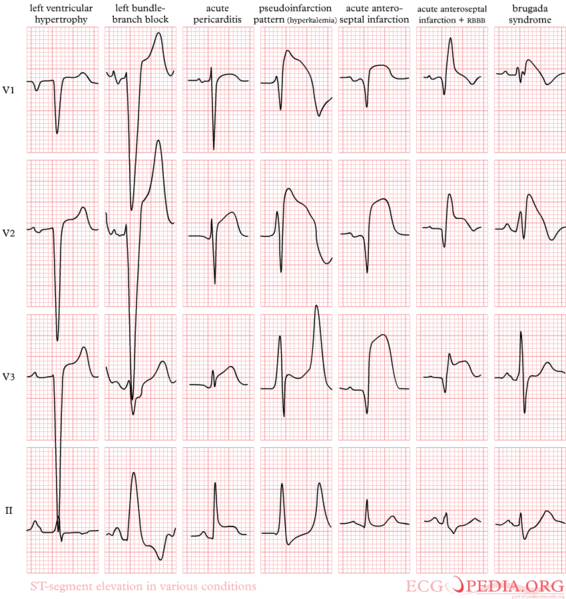
Shown below is an example of EKG demonstrating ST elevation in lead V1 and aVr; reversal of V6.

Shown below is an example of EKG demonstrating acute inferior ST segment elevation MI (STEMI). Note the ST segment elevation in leads II, III, and aVF along with reciprocal ST segment depression in leads I and aVL.
Shown below is an example of EKG illustrating Acute inferior myocardial infarction with RV involvement.
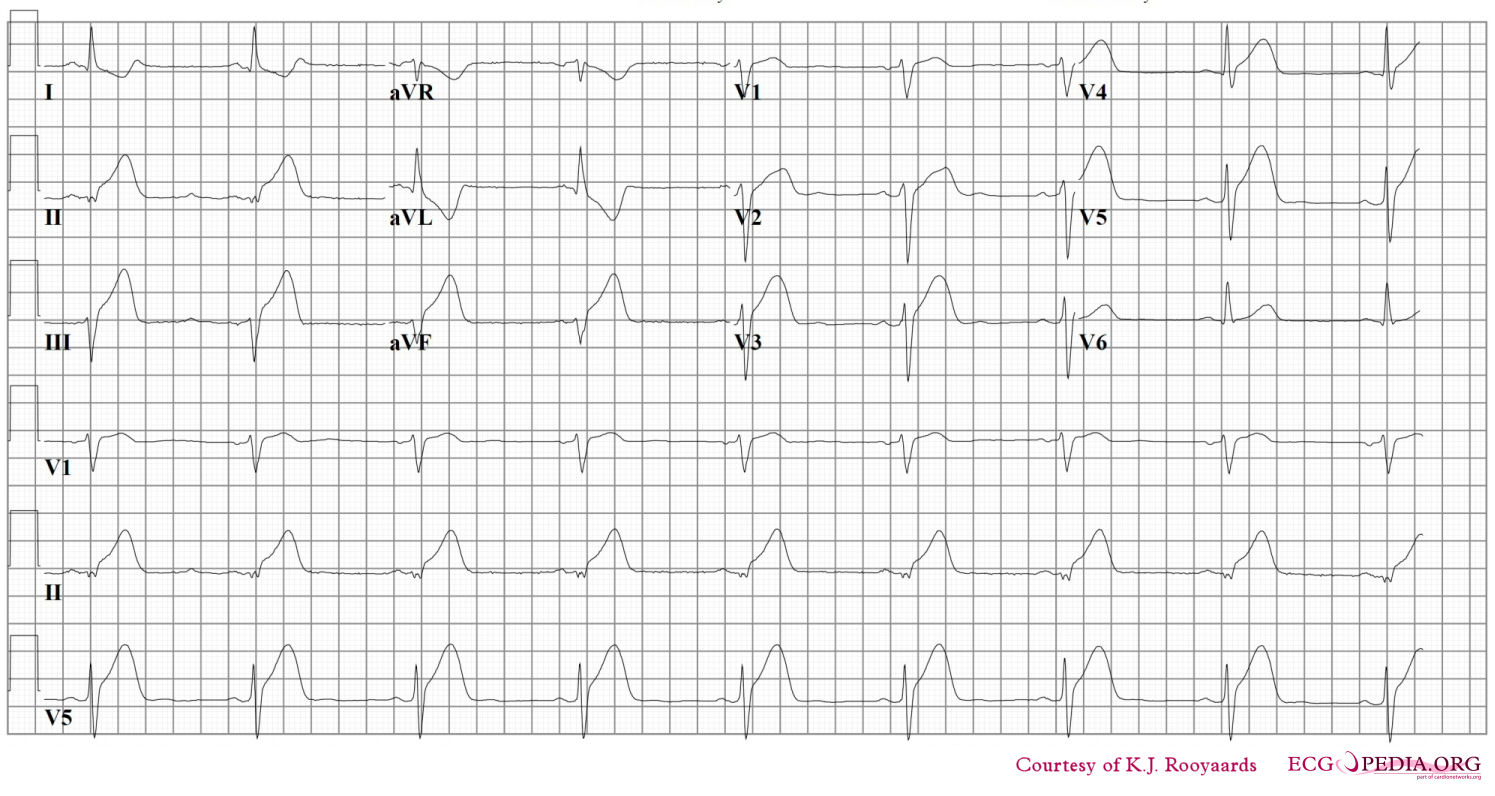
Shown below is an example of EKG demonstrating STEMI changes in the right precordial leads

Shown below is the EKG recording shows sinus rhythm. The remarkable feature is the some what poor R wave progression in the V1 and V2 leads and the ST elevation and T wave changes in leads V1 to V4 and I and aVL. The cardiogram suggests an anterior/ lateral MI possibly acute. There is also terminal P wave negativity in V1 suggesting a left atrial abnormality.
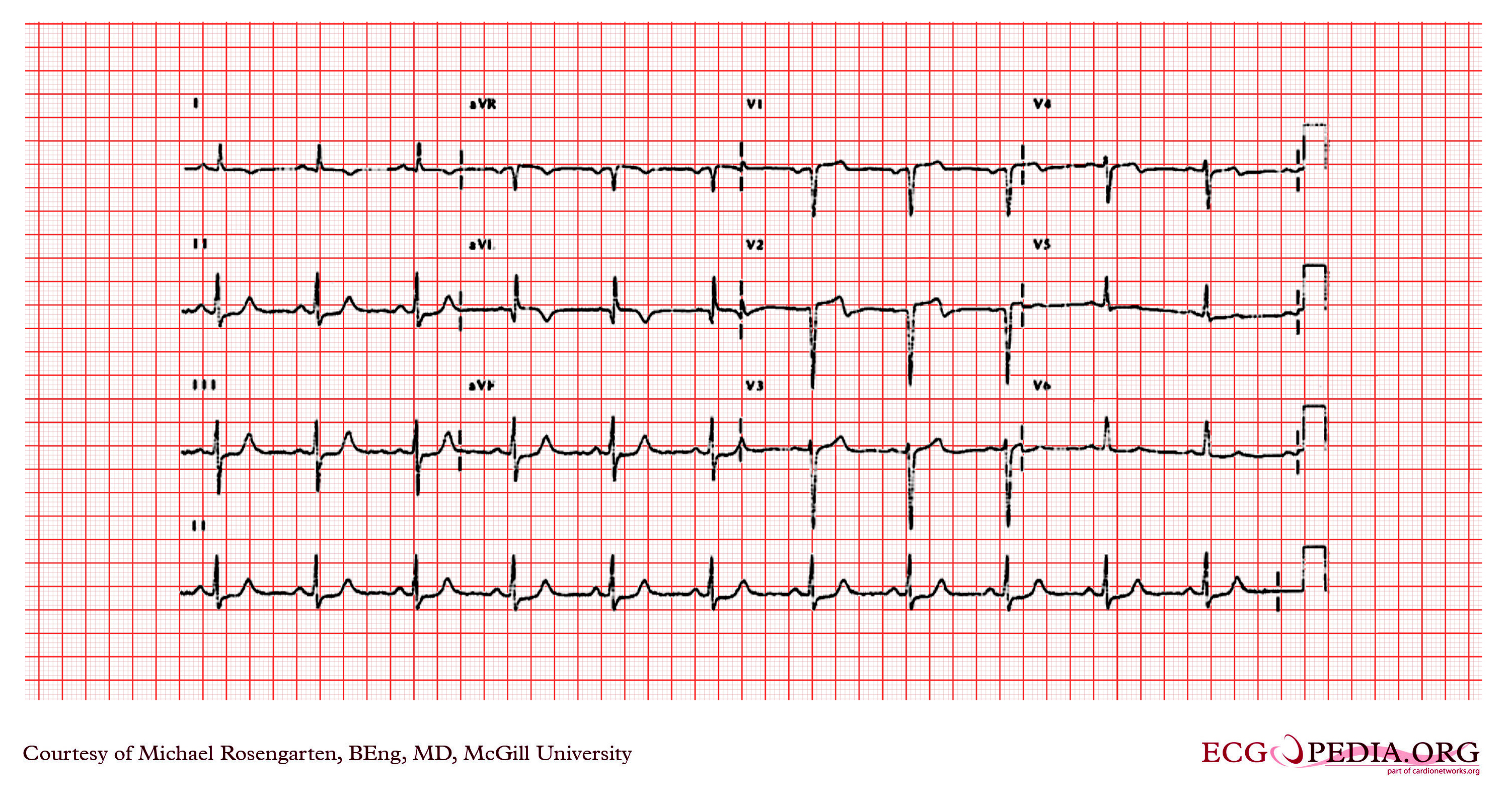
Shown below is an example of EKG illustrating acute inferior MI. ST elevation in the precordial and limb leads.
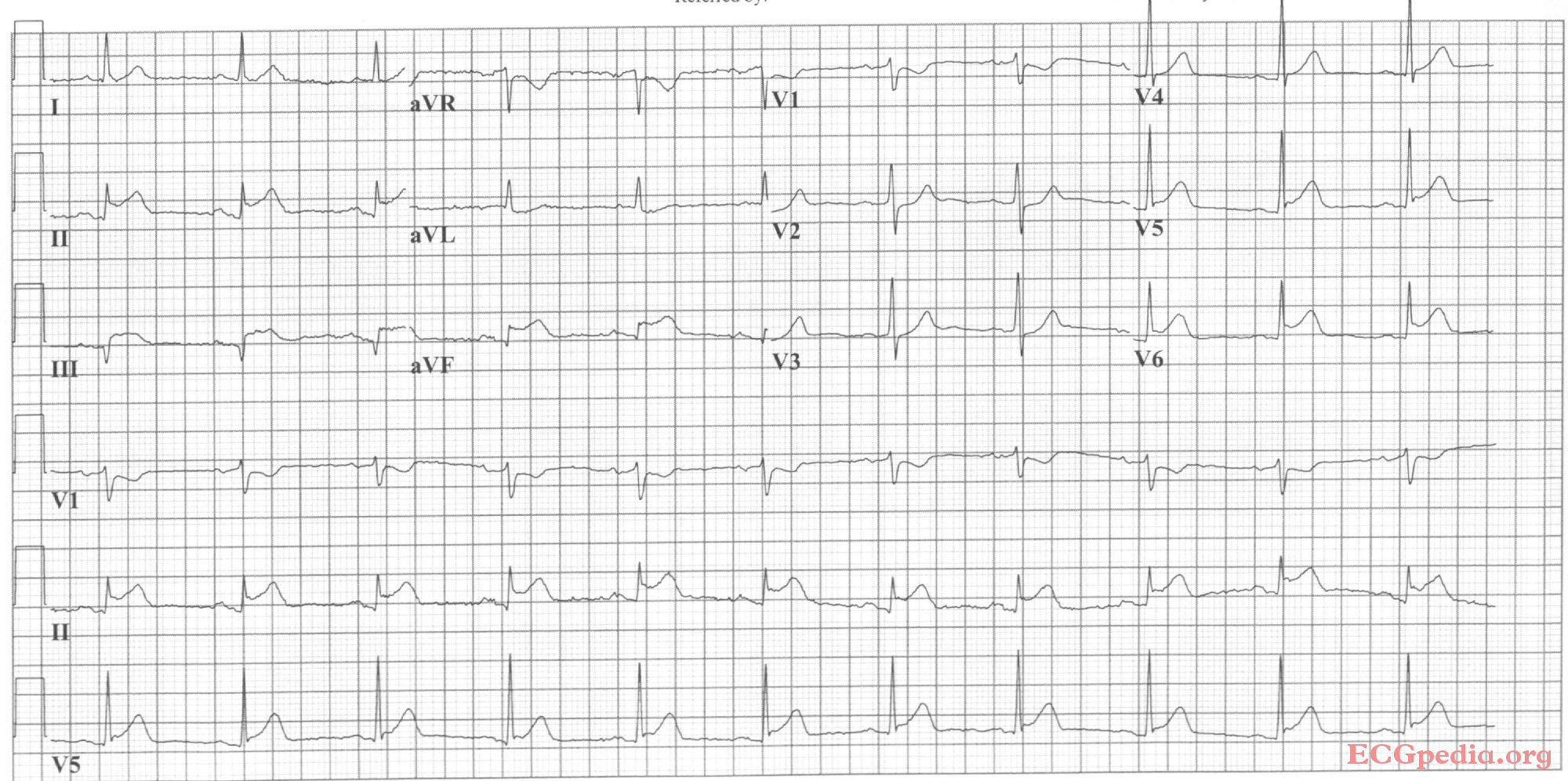
Shown below is an example of EKG showing Acute inferoposterior MI: ST elevation in II, III, AVF (in III > II). ST depression in I, AVL, V2. Tall R in V2, otherwise normal QRS morphology.
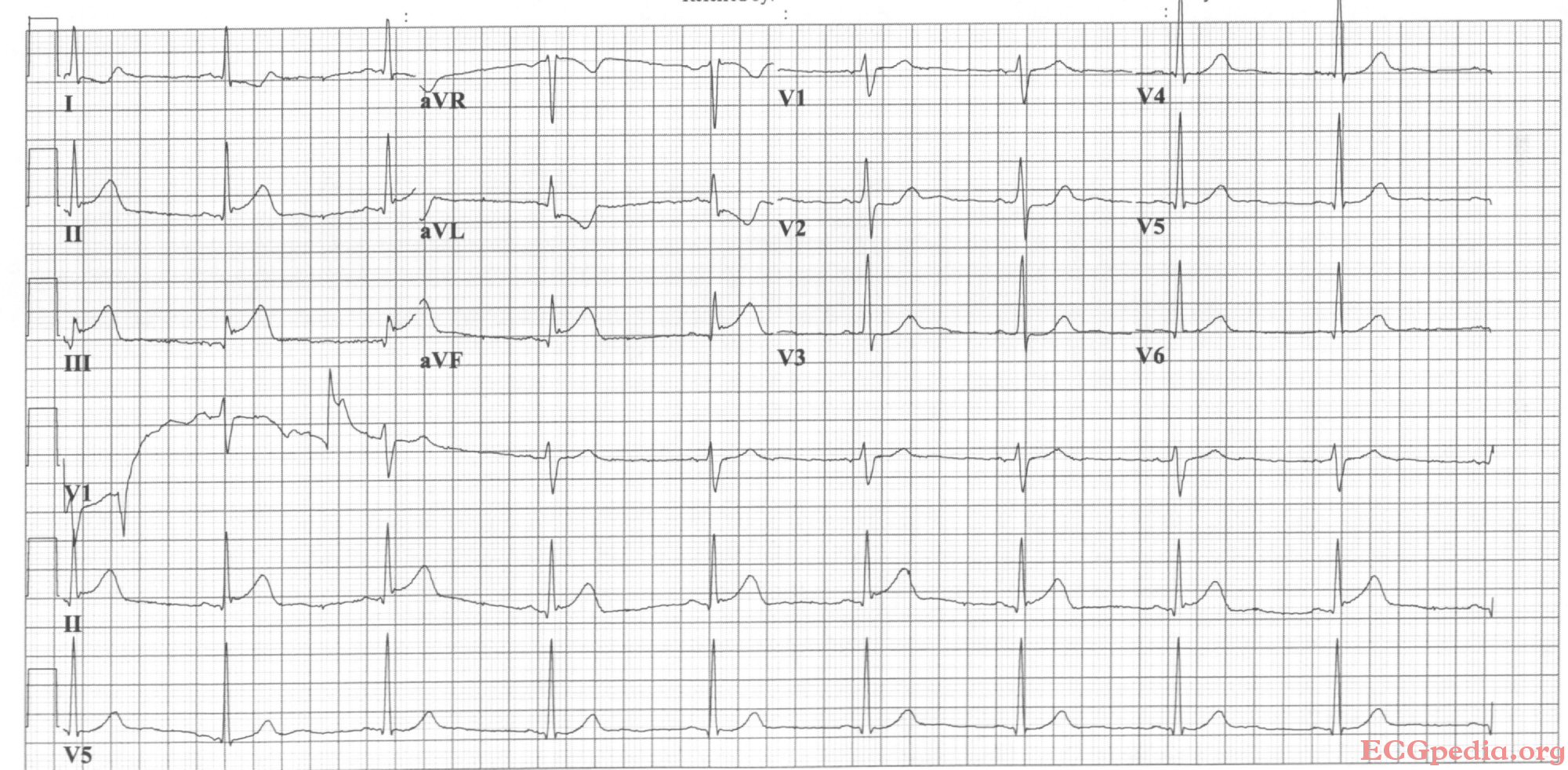
Shown below is an example of EKG demonstrating changes during acute inferior MI.

Shown below is an example of EKG demonstrating changes during acute posterolateral MI

Shown below is an example of EKG showing acute inferolateral MI: ST depression in V1, V4, tall R in V2. ST elevation in II, III, AVF, V5 and V6.
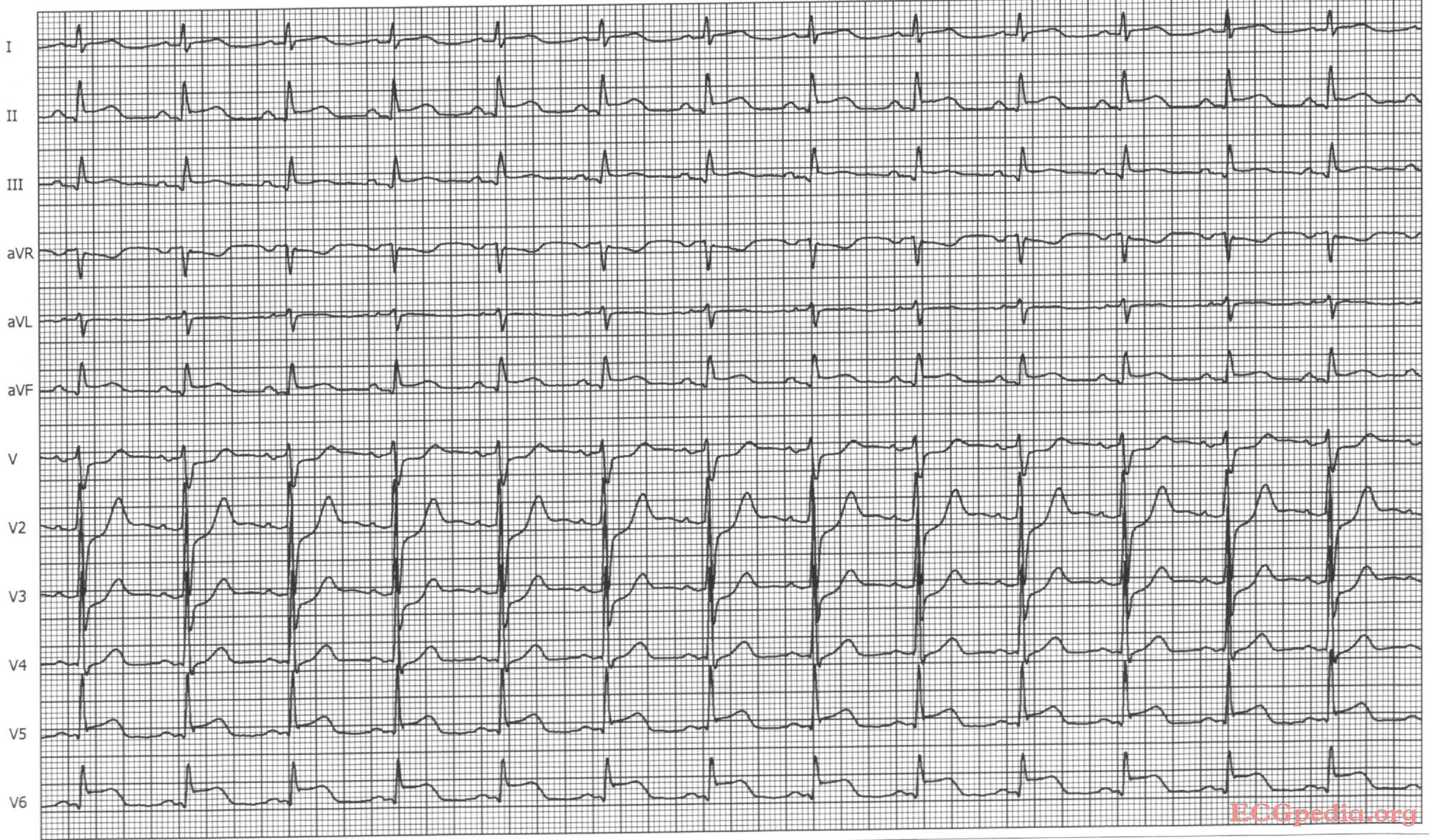
Shown below is an example of EKG demonstrating cute anterior MI. Loss of R waves throughout the anterior wall (V1-V6). QS complexes in V3-V5. ST elevation in V1-V5 with terminal negative T waves.
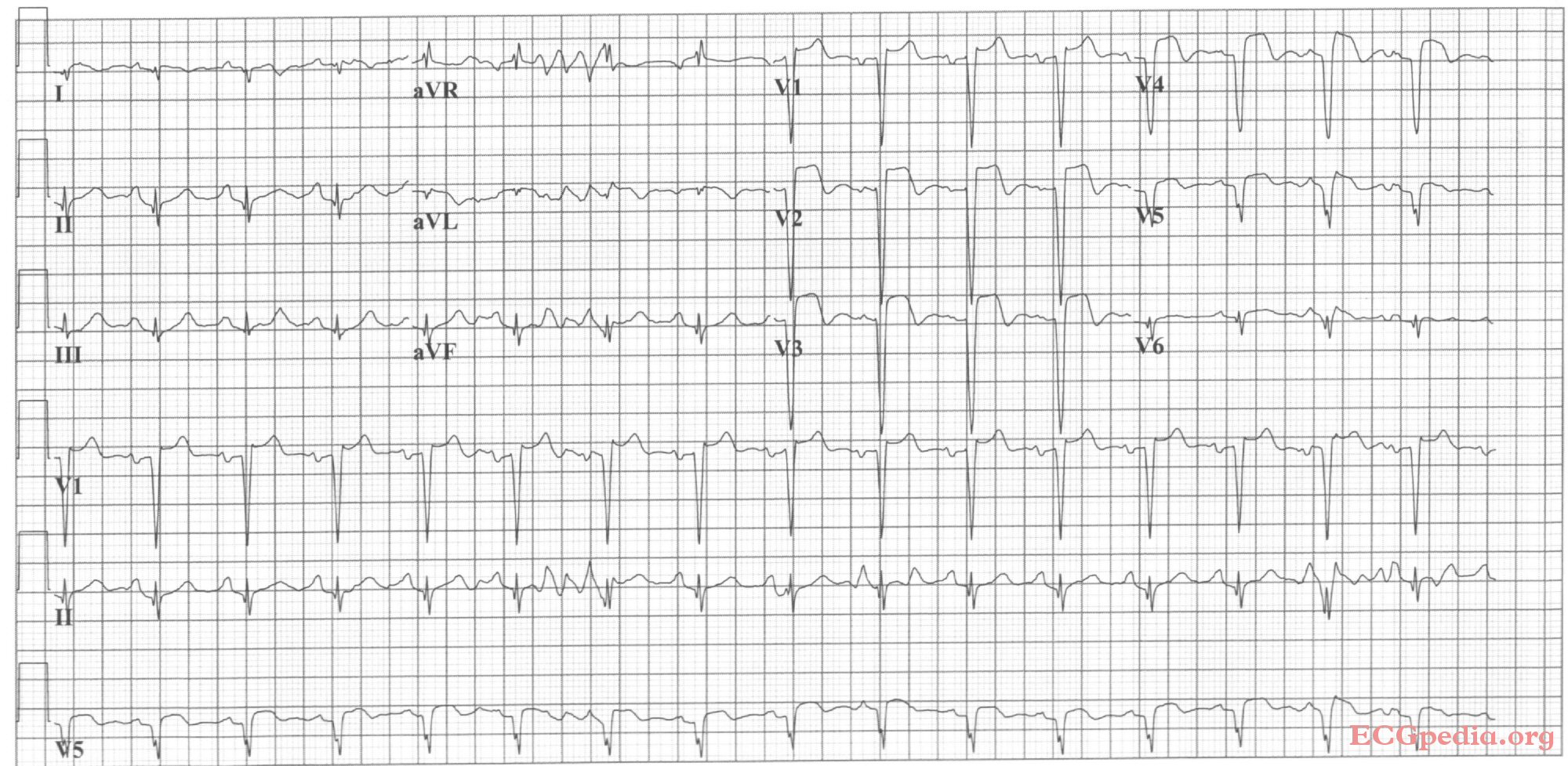
Shown below is an example of EKG with sinus bradycardia with first degree AV block and inferior-posterior-lateral myocardial infarction.

Shown below is an example of EKG showing sinus bradycardia with inferior-lateral myocardial infarction.

Shown below is an example of EKG demonstrating acute anterior MI. LAD artery occlusion.
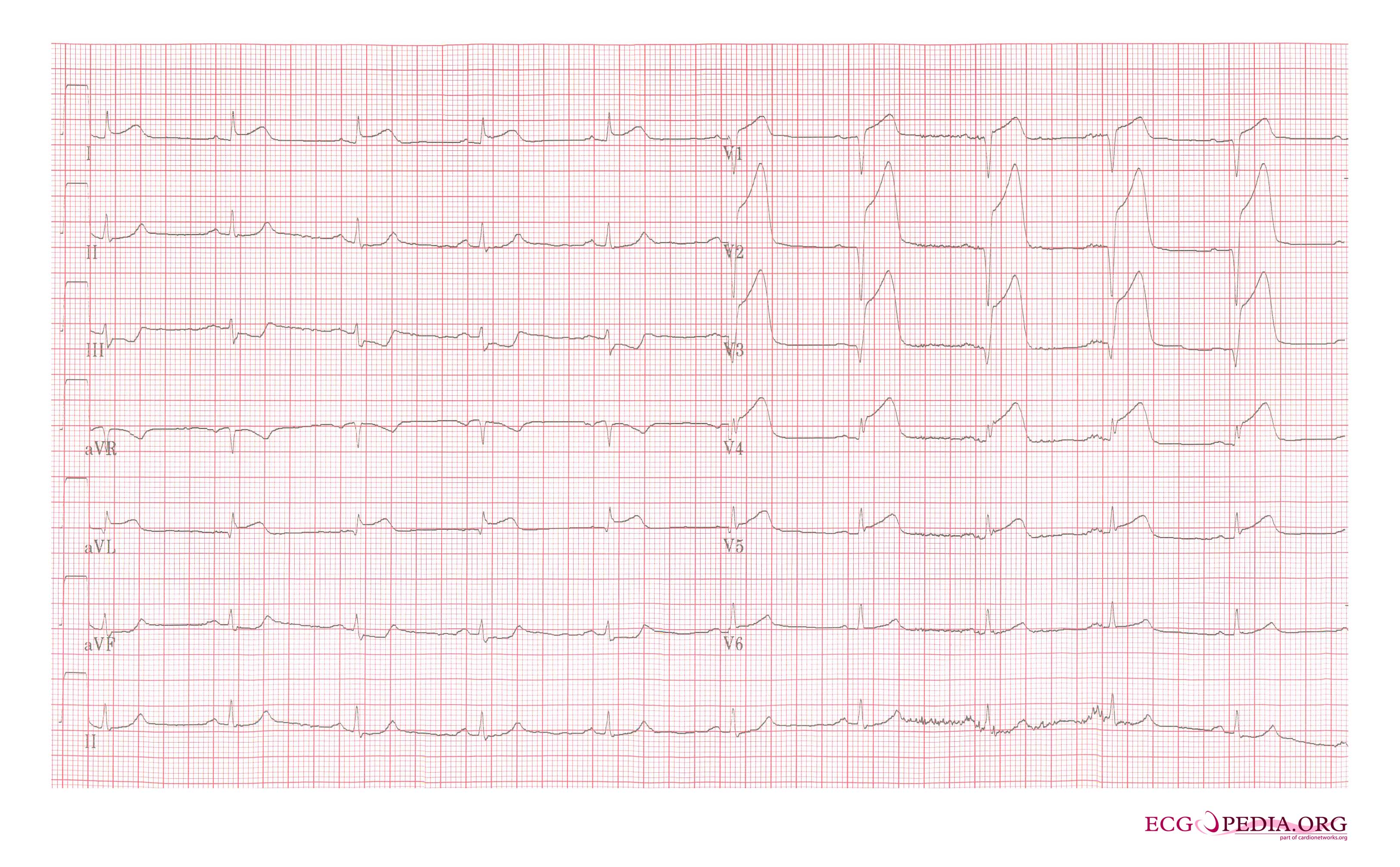
Shown below is an example of EKG showing sinus rhythm with anteroseptal myocardial infarction.

Shown below is an example of EKG demonstrating sinus rhythm with left bundle branch block, comparison with an old EKG is mandatory to evaluate whether the LBBB is new (a sign of myocardial infarction) or old.
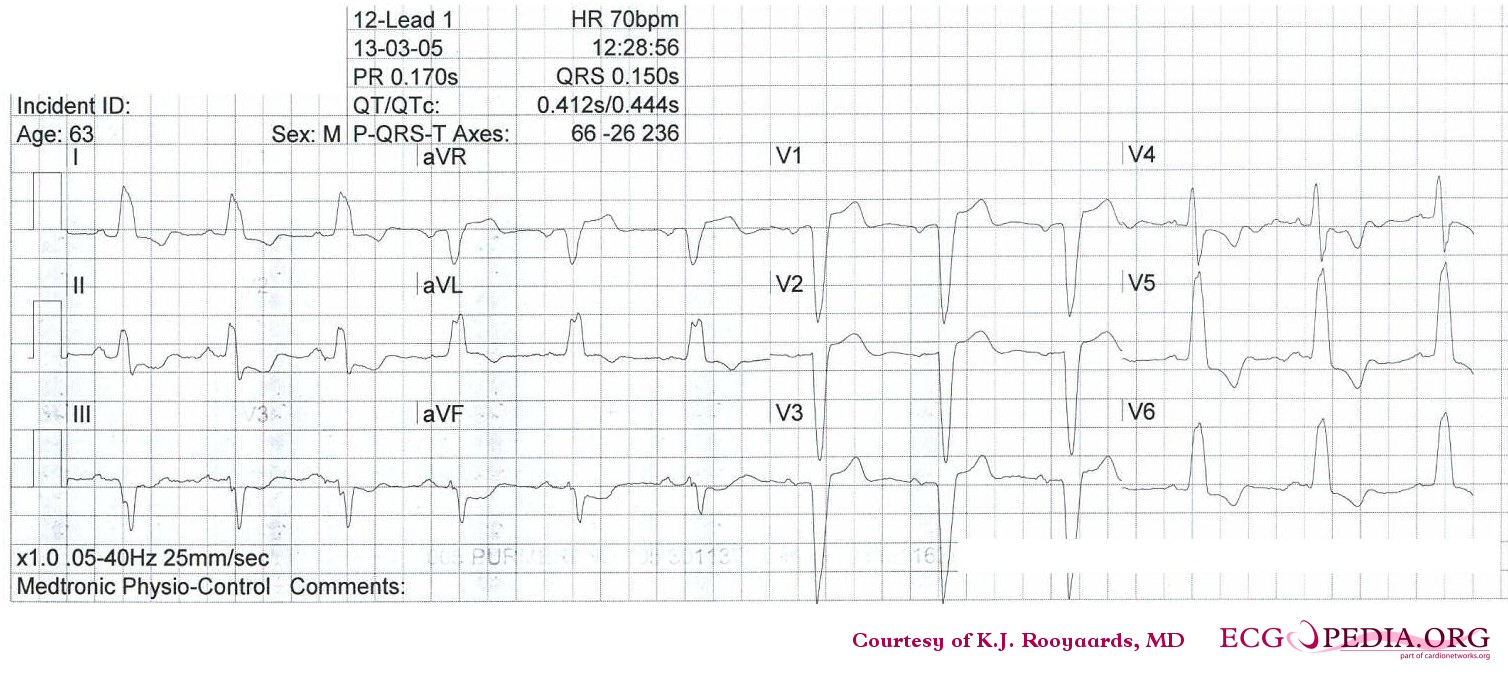
Shown below is an example of EKG illustrating inferior-posterior myocardial infarction with complete AV block and ventricular excape rhythm with RBBB pattern and left axis, followed by sinus rhythm.

Shown below is an example of EKG showing acute anterior myocardial infarction and left anterior hemiblock.

Shown below is an example of EKG demonstrating old anterior myocardial infarction and bifascicular block (RBBB and LAHB)

Image courtesy of Dr Jose Ganseman
Shown below is an example of an EKG illustrating acute MI with proximal LAD occlusion.

Shown below is an example of EKG demonstrating a 2 days old anterior infarction with Q waves in V1-V4 with persisting ST elevation, a sign of left ventricular aneurysm formation.
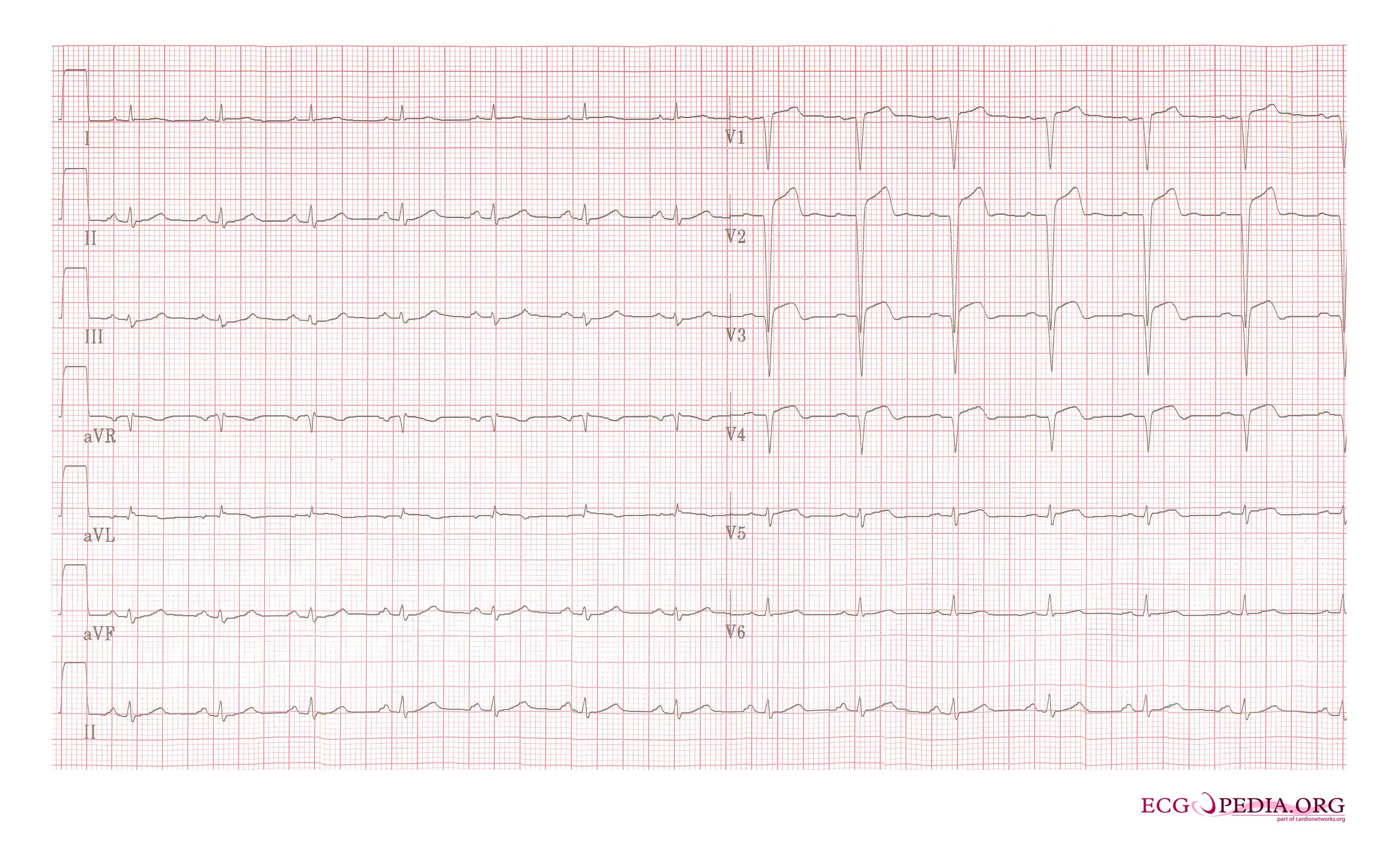
Shown below is an example of EKG demonstrating a 2 weeks old anterior infarction with Q waves in V2-V4 and persisting ST elevation, a sign of left ventricular aneurysm formation.

Shown below is an example of an EKG demonstrating a large anterior wall infarction on admission.
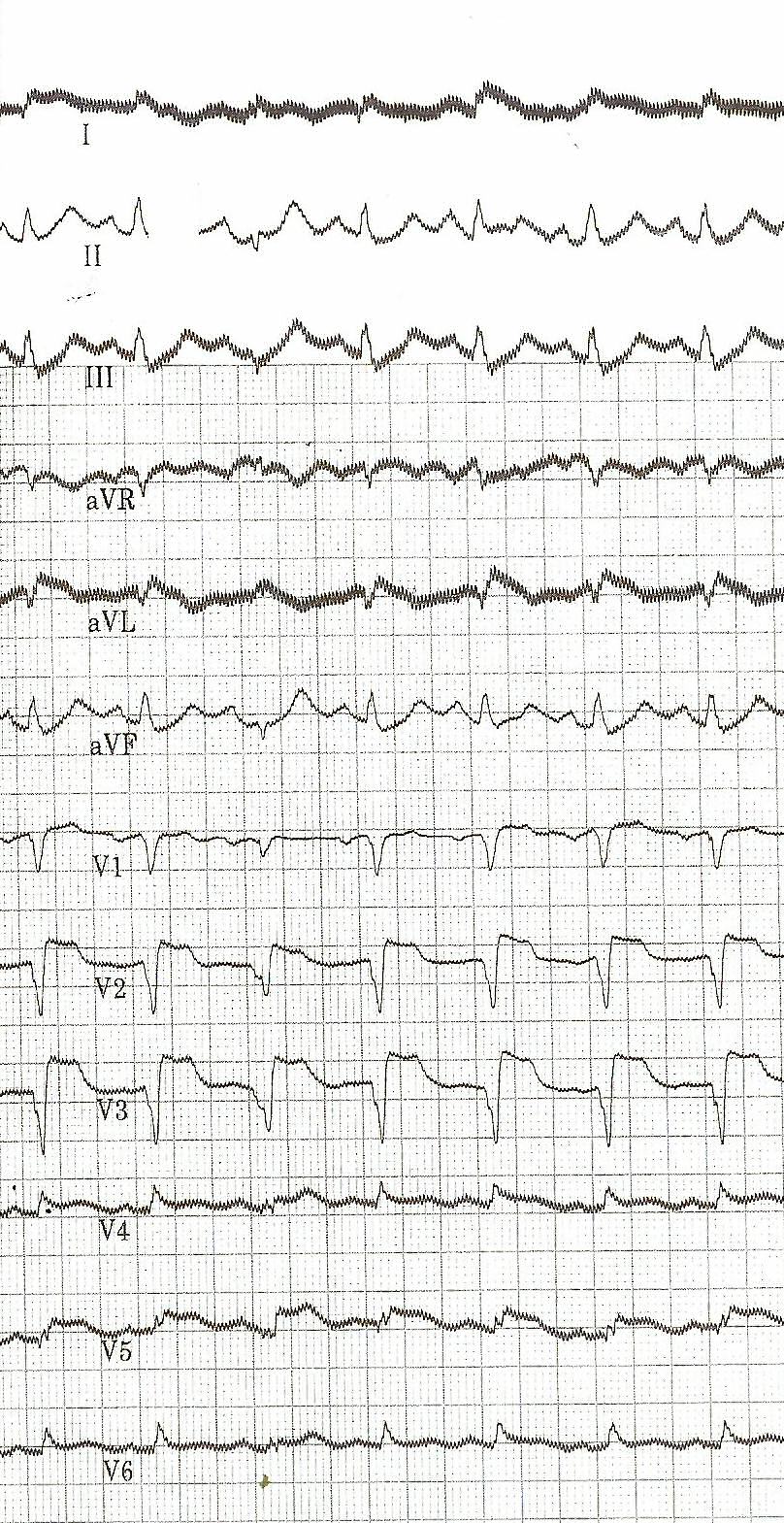
Shown below is an example of an EKG demonstrating ventricular fibrillation with increased heart rate and presence of two extra systoles short after each other.
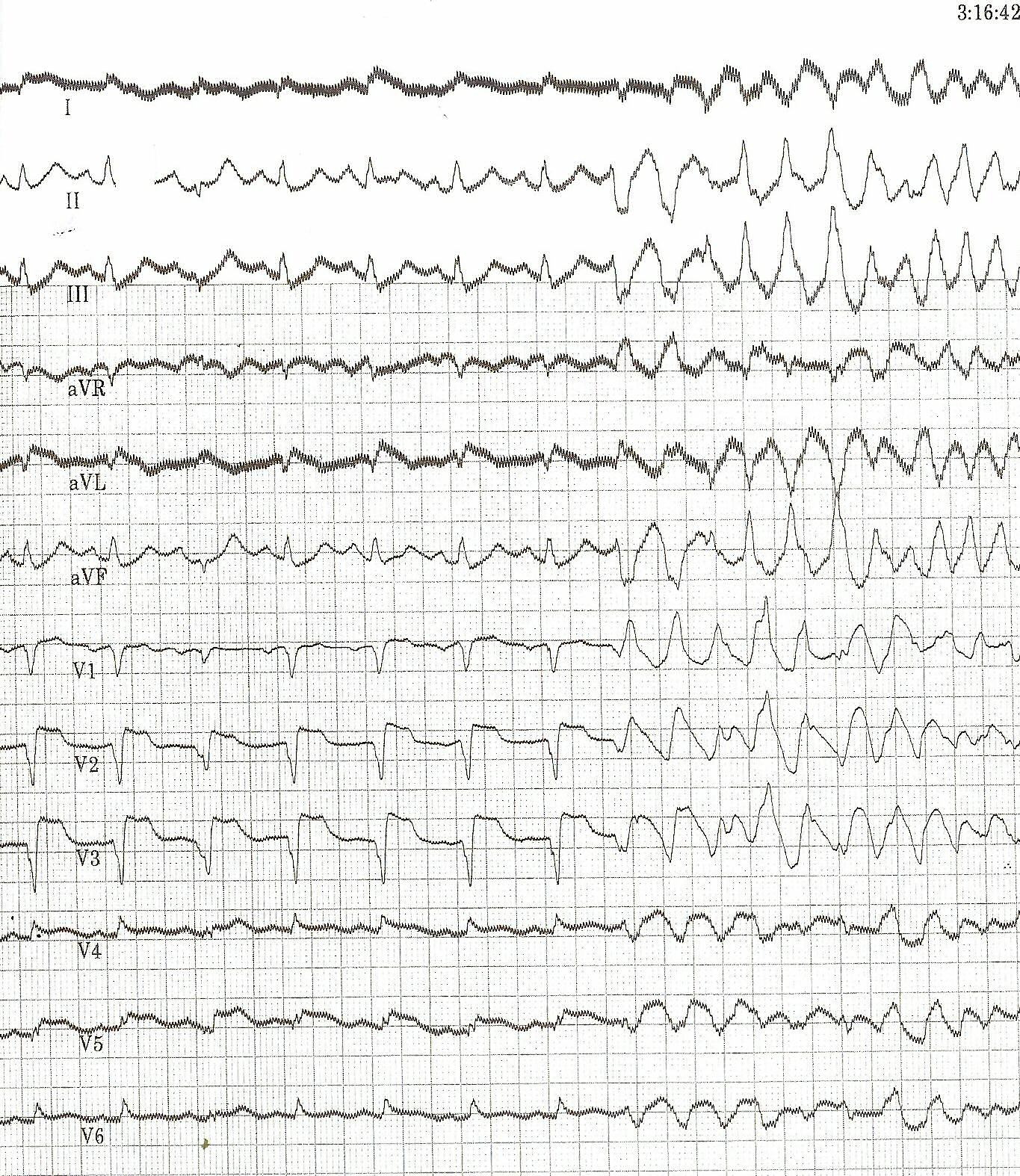
Shown below is an example of an EKG demonstrating a trial fibrillation and inferior-posterior myocardial infarction.
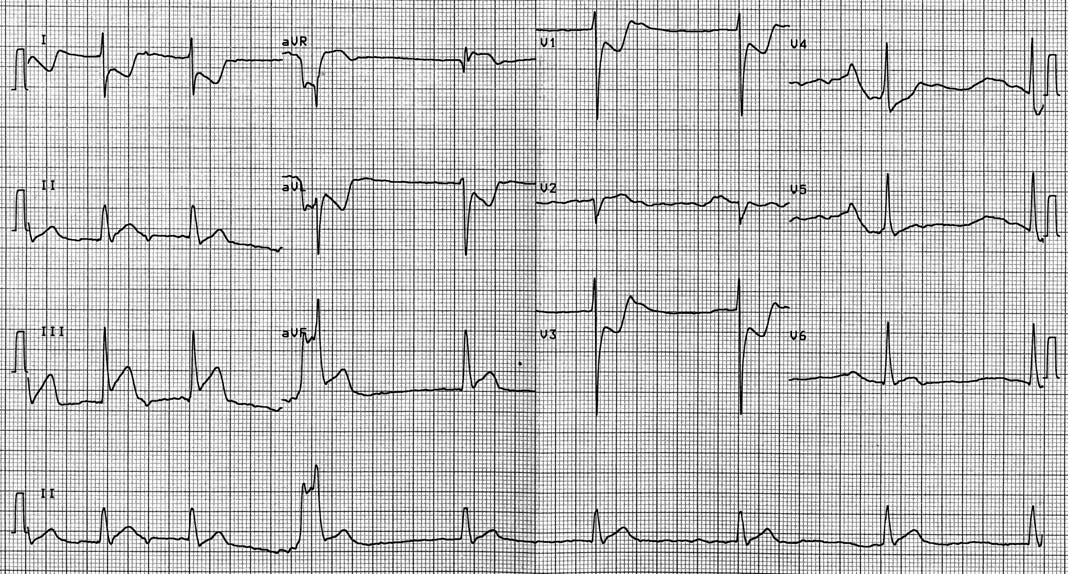
Shown below is an example of an EKG demonstrating clear ST elevation in the right precordial leads. A coronary angiography revealed a proximal right coronary artery occlusion.
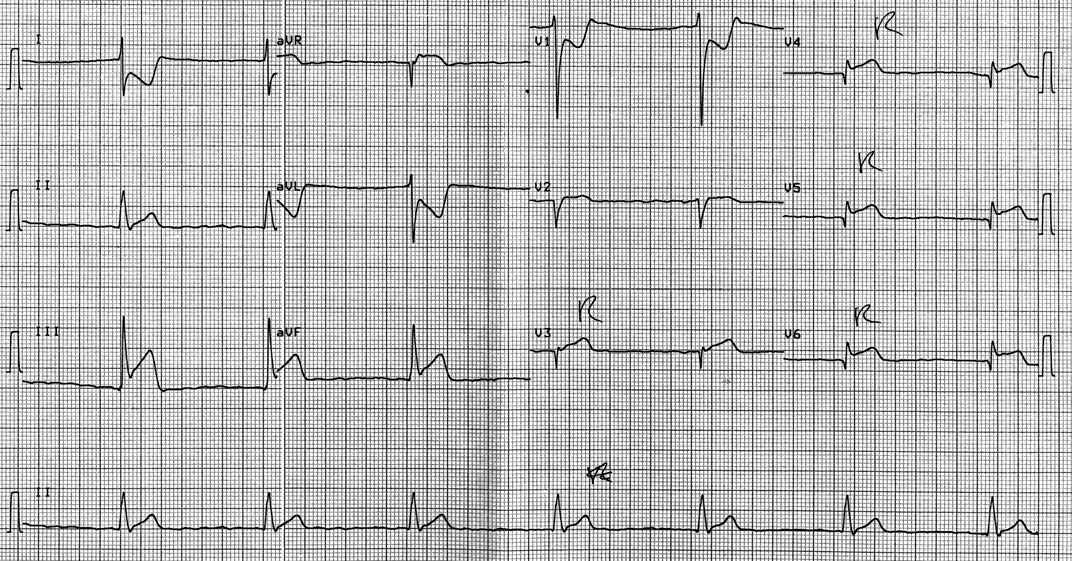
Shown below is an example of an EKG demonstrating inferior-posterior-lateral myocardial infarction with a nodal escape rhythm
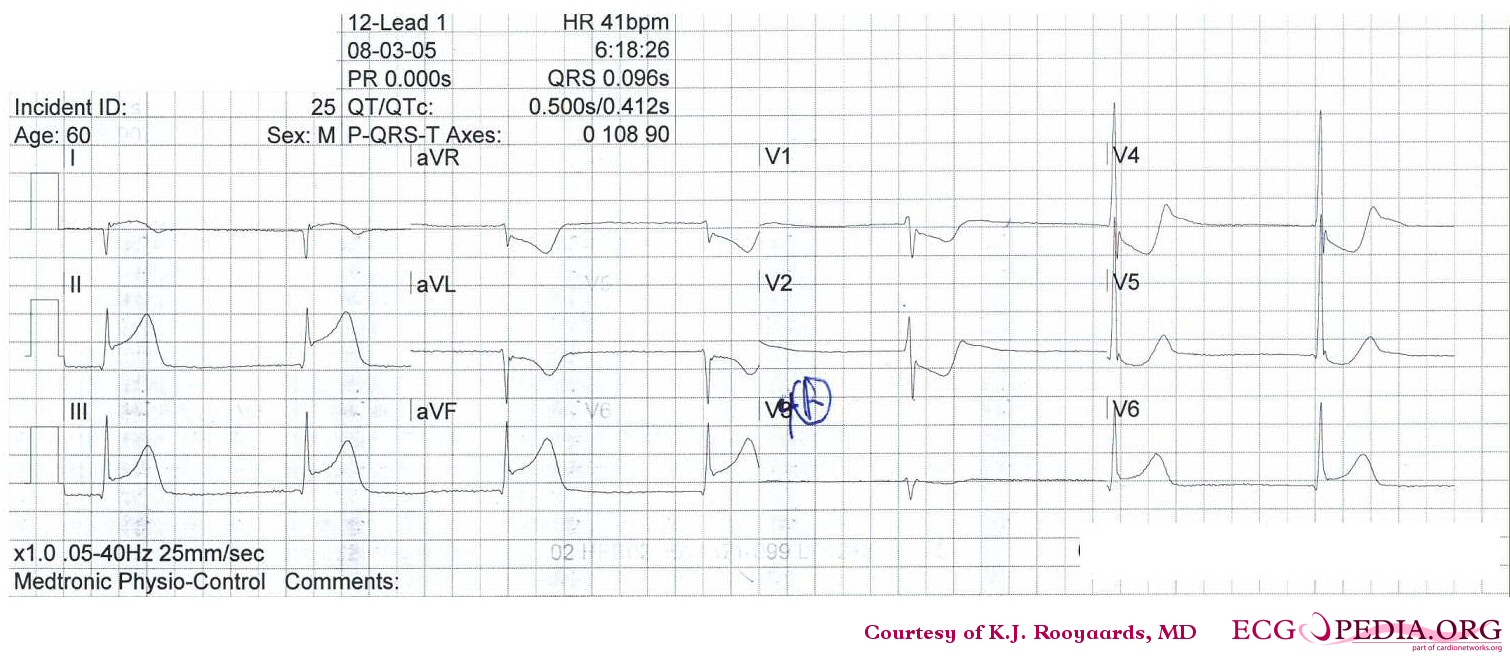
Shown below is an example of an EKG demonstrating RBBB and inferior MI. Note to left axis deviation.
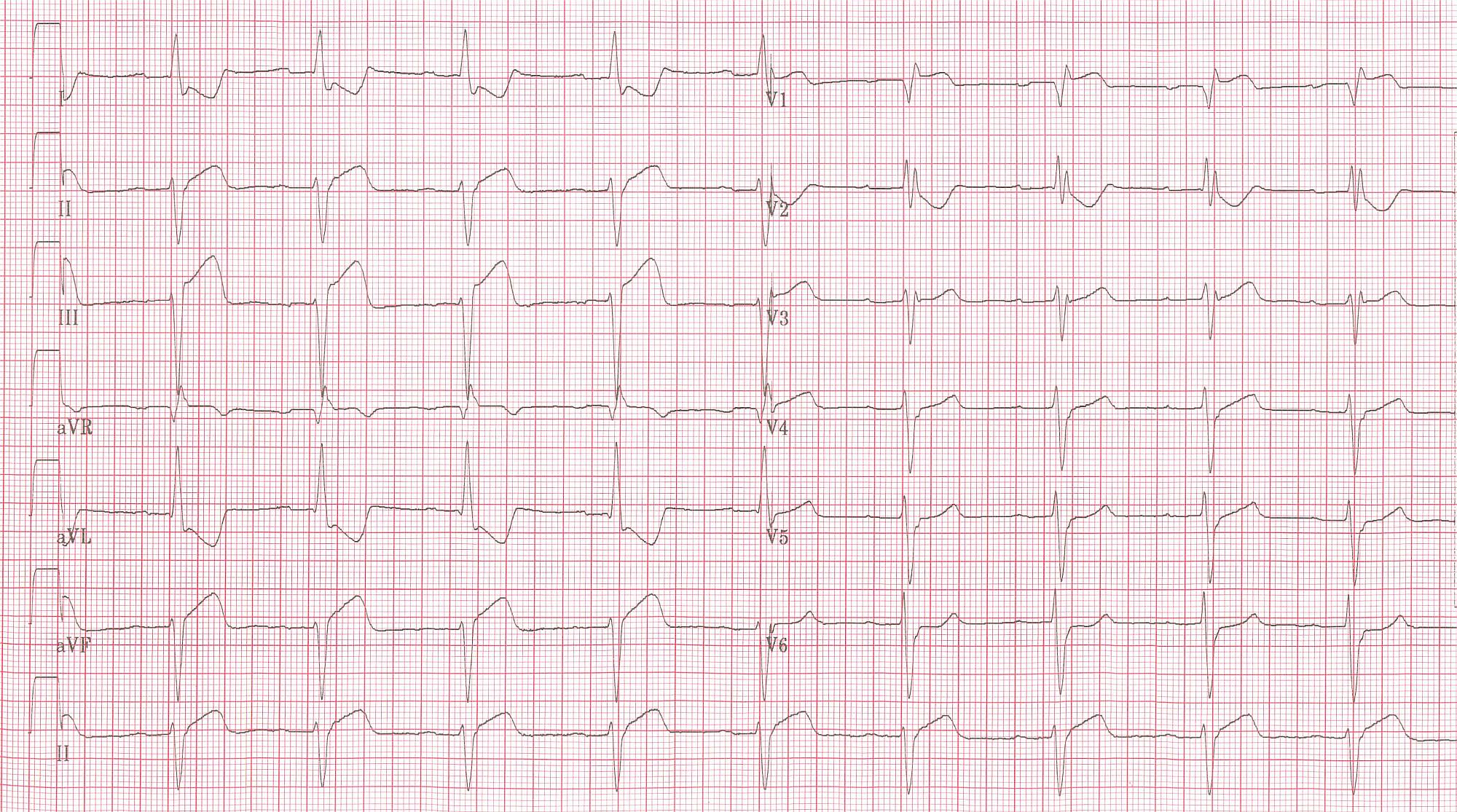
Shown below is an example of an EKG demonstrating lead V4R in the same patient with RBBB and inferior MI clearly shows ST elevation.

Shown below is an example of an EKG demonstrating cute myocardial infarction in in a patient with a pacemaker and LBBB. Concordant ST elevation in V5-V6 are clearly visible. There is discordant ST segment elevation > 5 mm in lead V3.

Shown below is an example of an EKG demonstrating findings in the same patient as in the first example 2 months before the myocardial infarction. Normal LBBB pattern.
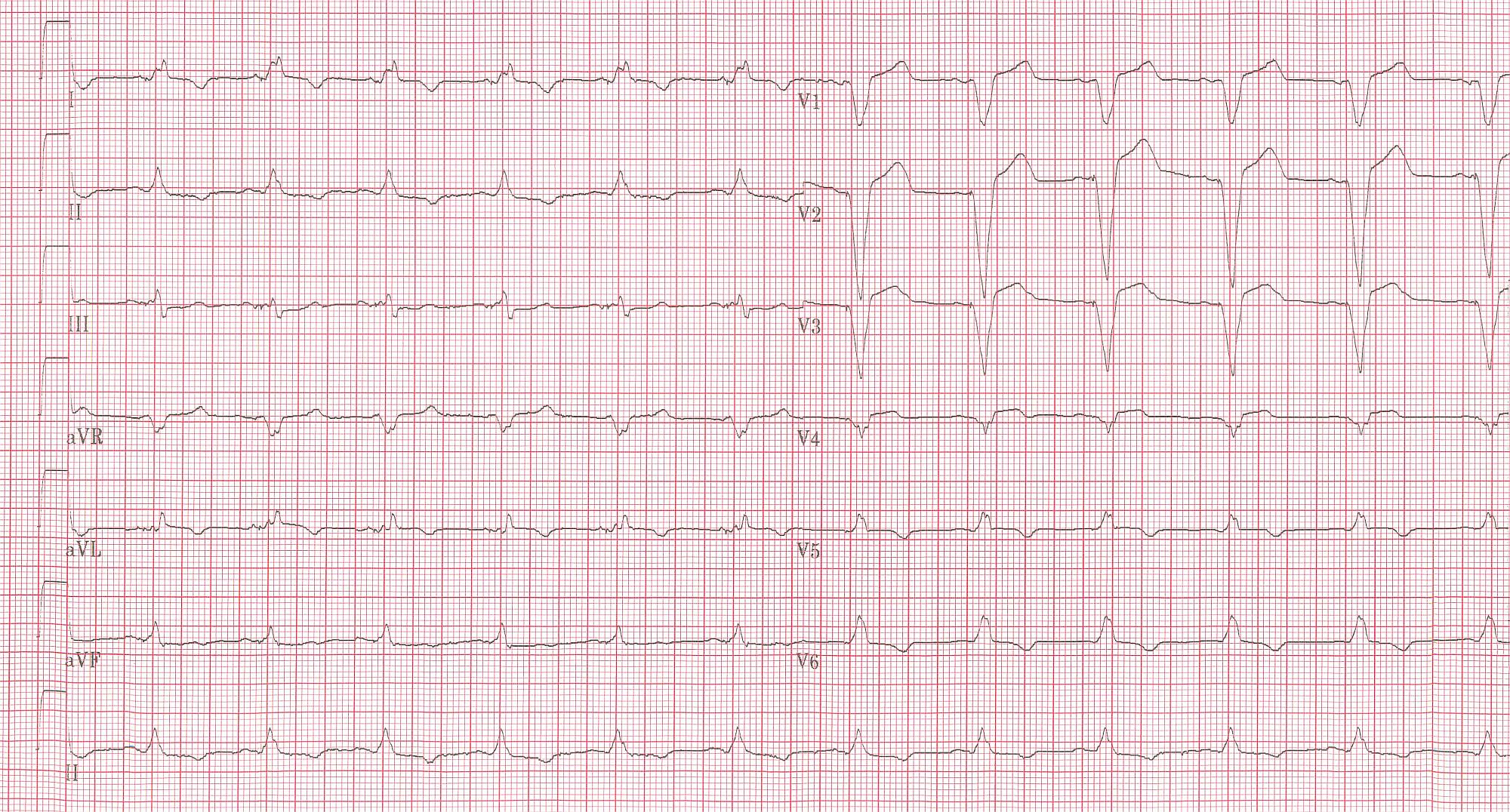
Shown below is an example of an EKG demonstrating acute MI in a patient with LBBB
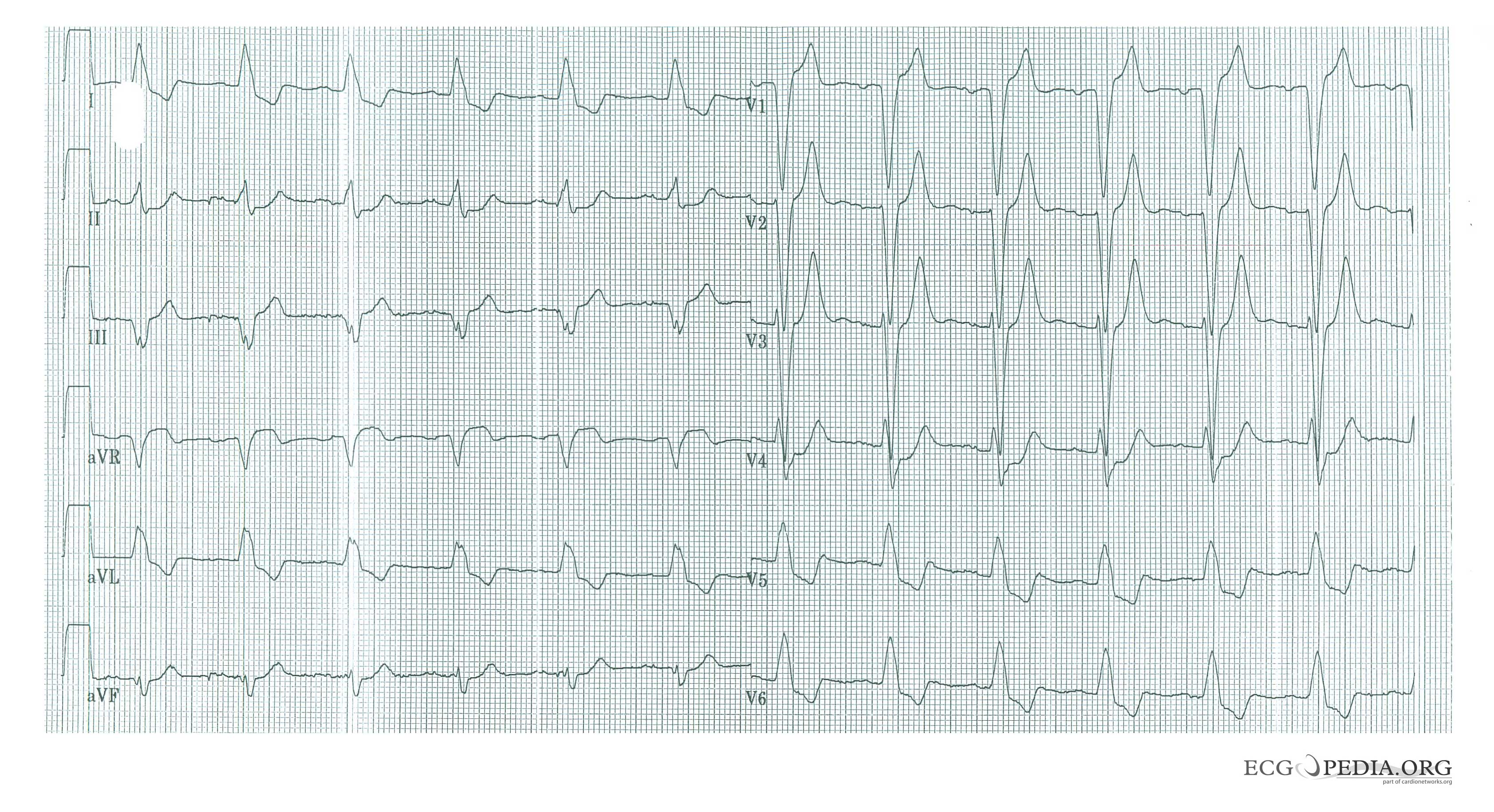
Shown below is an example of an EKG demonstrating Wellens' sign in proximal LAD lesion; characterized by symmetrical, often deep >2mm, T wave inversions in the anterior precordial lead; classically occurs during pain free period

Shown below is an example of an EKG demonstrating atrial fibrillation with inferior-posterior-lateral myocardial infarction and incomplete right bundle branch block. Lead I shows ST depression, suggestive of right coronary artery involvement.

Shown below is an example of an EKG demonstrating ypical negative T waves post anterior myocardial infarction. This patient also shows QTc prolongation. Whether this has an effect on prognosis is debated. [1][2][3]
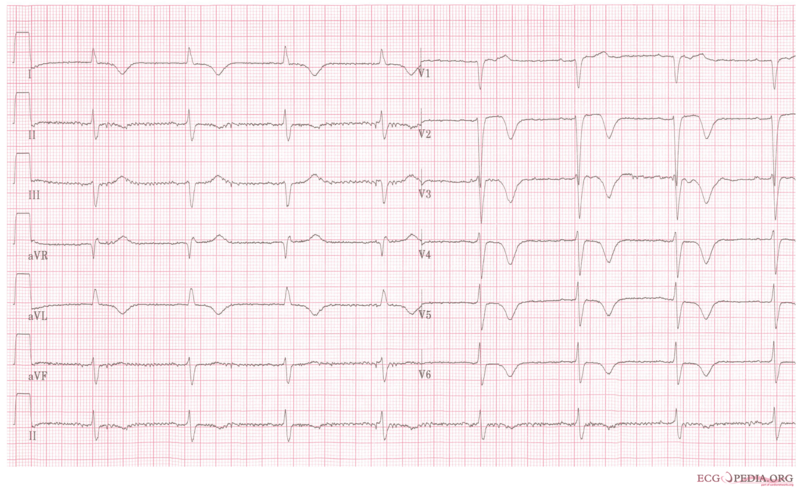
Shown below is an example of an EKG showing ST elevation in the anterior precordial leads, low voltages in all the leads, poor R wave progression in the precordial leads.
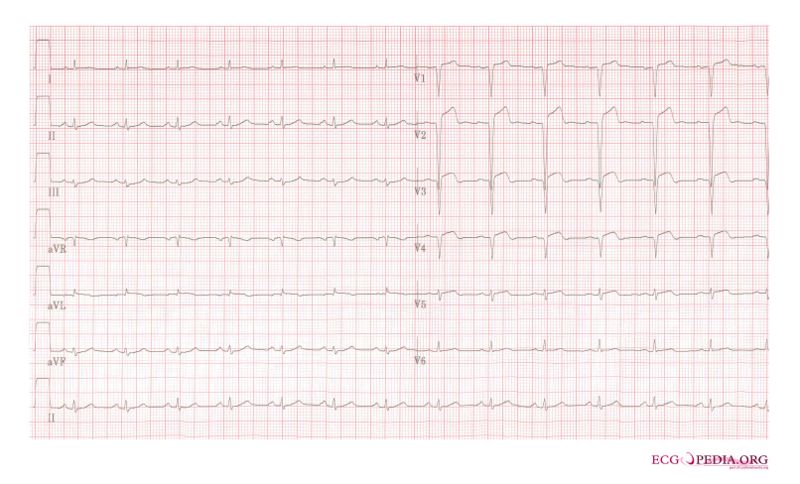
Shown below is an example of EKG demonstrating ST segment elevation in precordial leads signifying anterior myocardial infarction.
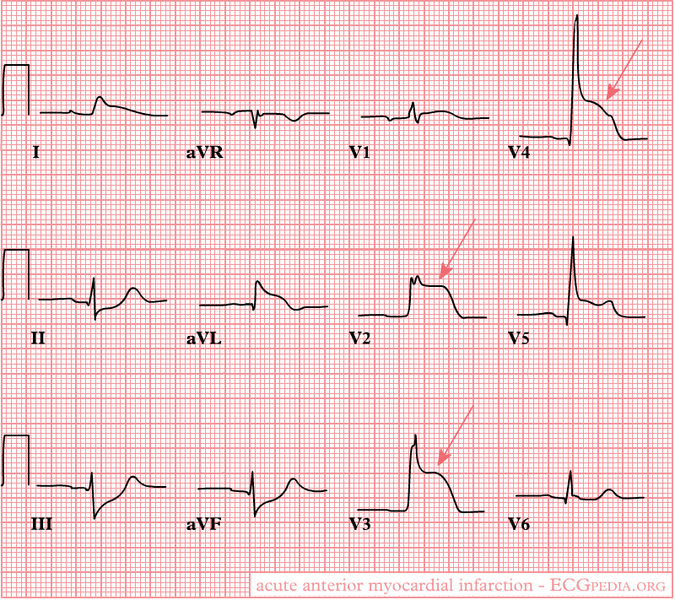
Sources
Copyleft images obtained - courtesy of EKGpedia, [2]
References
- ↑ Novotný T, Sisáková M, Floriánová A; et al. (2007). "[QT dynamicity in risk stratification in patients after myocardial infarction]". Vnitr Lek (in Czech). 53 (9): 964–7. PMID 18019666. Unknown parameter
|month=ignored (help) - ↑ Jensen BT, Abildstrom SZ, Larroude CE; et al. (2005). "QT dynamics in risk stratification after myocardial infarction". Heart Rhythm. 2 (4): 357–64. doi:10.1016/j.hrthm.2004.12.028. PMID 15851335. Unknown parameter
|month=ignored (help) - ↑ Chevalier P, Burri H, Adeleine P; et al. (2003). "QT dynamicity and sudden death after myocardial infarction: results of a long-term follow-up study". J. Cardiovasc. Electrophysiol. 14 (3): 227–33. PMID 12716101. Unknown parameter
|month=ignored (help)